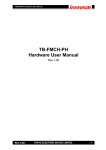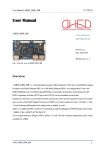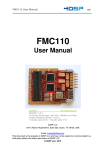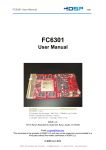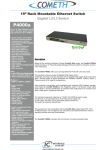Download VP680 User Manual
Transcript
VP680 User Manual r1.5 VP680 User Manual 4DSP LLC, USA Email: [email protected] This document is the property of 4DSP LLC and may not be copied nor communicated to a third party without the written permission of 4DSP LLC © 4DSP LLC 2015 VP680 User Manual r1.5 Revision History Date Revision Revision 2011-03-23 Draft 0.1 2011-05-11 Added FPGA pin out tables. Textual changes. Internally reviewed. 0.2 2011-05-12 Added direction information on peripheral pins. Added FLASH and configuration info. Added BLAST VIO matrix. 0.3 2011-05-12 Release 1.0 2011-05-13 Added product photo. Update errata appendix. 1.1 2011-08-01 Correction of commercial temperature range. 1.2 2011-09-09 Added OpenVPX profile specification. Added weight specification. 1.3 2014-08-21 Added description to section 3.1.2 about a mechanical exception made to the VITA 48.2 standard with regards to the clamshell. Added conduction-cooled clamshell drawing. 1.4 2015-06-22 Added detail to power supply section, replaced references to Virtex5 with Virtex6 1.5 UM004 VP680 User Manual www.4dsp.com -2- VP680 User Manual r1.5 Table of Contents 1 Acronyms and related documents ............................................................................. 5 1.1 Acronyms ................................................................................................................ 5 1.2 Related Documents ................................................................................................. 6 2 General description ..................................................................................................... 7 2.1 OpenVPX ................................................................................................................ 8 3 Hardware Specifications ............................................................................................. 8 3.1 Phycisal specifications ............................................................................................ 8 3.1.1 Air-cooled ......................................................................................................... 8 3.1.2 Conduction cooled ........................................................................................... 8 3.1.3 Backplane keying ............................................................................................. 9 3.1.4 Front panel layout ............................................................................................ 9 3.2 VPX P0 Connector .................................................................................................10 3.2.1 Power supply ..................................................................................................10 3.2.2 Utility plane .....................................................................................................10 3.2.3 System reset (SYSRESET*)............................................................................11 3.2.4 Bussed GPIO (GDiscrete1) .............................................................................11 3.2.5 Battery supply (P1-VBAT) ...............................................................................11 3.3 VPX P1 Connector .................................................................................................11 3.4 VPX P2 Connector .................................................................................................14 3.5 Virtex-6 FPGA device .............................................................................................16 3.6 Front panel I/O .......................................................................................................16 3.6.1 UART over USB ..............................................................................................16 3.6.2 Status LEDs (CPLD) .......................................................................................16 3.6.3 Debug LEDs (FPGA) .......................................................................................17 3.7 FPGA Mezzanine Card (FMC) ...............................................................................17 3.7.1 Bank A (LA, HA) connections ..........................................................................18 3.7.2 Bank B (HB) connections ................................................................................21 3.7.3 Gigabit transceiver connections ......................................................................23 3.7.4 Miscellaneous FMC connections .....................................................................23 3.7.1 I/O Standard Support ......................................................................................24 3.7.2 VADJ Programming ........................................................................................24 3.8 BLAST sites ...........................................................................................................24 3.9 Clock Tree..............................................................................................................25 3.9.1 AUX_CLK+/- Reference Clock ........................................................................26 3.9.2 REF_CLK+/- Reference Clock.........................................................................26 3.9.3 On-board MGT Reference Clock .....................................................................27 3.9.4 FMC MGT Reference Clock ............................................................................27 3.9.1 FMC Clock connections ..................................................................................28 3.9.2 Miscellaneous clock connections.....................................................................28 UM004 VP680 User Manual www.4dsp.com -3- VP680 User Manual r1.5 3.10 Local I2C bus ......................................................................................................28 3.10.1 Clock Synthesizer (CDCE925) ........................................................................29 3.10.2 On-board Voltage and Temperature Monitoring (ADT7411) ............................29 3.11 Serial FLASH ......................................................................................................30 FPGA Configuration .........................................................................................................31 3.11.1 JTAG chain .....................................................................................................31 3.11.2 FLASH storage................................................................................................32 3.11.3 Configuration Controller (CPLD) ......................................................................33 3.11.4 User image programming ................................................................................33 3.11.5 Safety Configuration Jumper ...........................................................................33 4 Environment Specifications .......................................................................................34 4.1 Temperature ..........................................................................................................34 4.2 Convection cooling .................................................................................................34 4.3 Conduction cooling .................................................................................................34 5 Safety...........................................................................................................................34 6 EMC .............................................................................................................................34 7 Warranty ......................................................................................................................35 Appendix A: FPGA Bank Mapping ....................................................................................36 Appendix B: Errata .............................................................................................................38 UM004 VP680 User Manual www.4dsp.com -4- VP680 User Manual r1.5 1 Acronyms and related documents 1.1 Acronyms UM004 A/D Analog to Digital Converter BLAST Board Level Advanced Scalable Technology CPLD Complex Programmable Logic Device D/A Digital to Analog Converter DCI Digitally Controlled Impedance DDR Double Data Rate DSP Digital Signal Processing FBGA Fineline Ball Grid Array FFT Fast Fourier Transformation FMC FPGA Mezzanine Card FPDP Front Panel Data Port FPGA Field Programmable Gate Array GPIO General Purpose Input/Output GUI Graphical User Interface HPC High pin count IP Intellectual Property JTAG Join Test Action Group LED Light Emitting Diode LSB Least Significant Bit(s) LVDS Low Voltage Differential Signaling LVTTL Low Voltage Transistor Logic level MGT Multi-Gigabit Transceiver MSB Most Significant Bit(s) PCB Printed Circuit Board PCI Peripheral Component Interconnect PCIe PCI Express PLL Phase Locked Loop pps Pulse Per Second QDR Quadruple Data rate SDRAM Synchronous Dynamic Random Access memory VP680 User Manual www.4dsp.com -5- VP680 User Manual r1.5 sFPDP Serial FPDP SPI Serial Peripheral Interconnect SRAM Synchronous Random Access memory SRIO Serial Input/Output SSC Spread Spectrum Clocking TTL Transistor Logic level UART Universal Asynchronous Receiver/Transmitter USB Universal Serial Bus Table 1: Glossary 1.2 Related Documents UM004 ANSI/VITA 46.0-2007 Rev1.2, April 2008 ANSI/VITA 65-2010 Rev1.0, June 2010 ANSI/VITA 48.2-2010 Rev1.0, July 2010 ANSI/VITA 57.1-2010 Rev1.1, February 2010 IEEE 1101.2-1992 IEEE Standard for Mechanical Core Specifications for ConductionCooled Eurocards VP680 User Manual www.4dsp.com -6- VP680 User Manual r1.5 2 General description The VP680 is a high performance ANSI/VITA 46.0 VPX standard compliant card with advanced digital signal processing capabilities. The design has been targeted for customer programmable implementations of complex FPGA algorithms for Digital Signal Processing (DSP) applications. The VP680 product is in the 3U VPX form factor, offering various direct on-board interface options that are closely coupled to large - fast on-board memory resources of the Xilinx Virtex™-6 FPGA. The VP680 is an excellent choice for high performance applications that require the use of accelerated frequency-domain algorithms such as with FFTs. 4DSP offers many off-the-shelf Intellectual Property (IP) cores for applications that require the highest level of performance. optional FMC VITA 57.1 160 single ended 80 LVDS pairs Mini USB (UART) optional 1 4x MGT 3.125Gbps 128 Mbit SPI FLASH 2 Virtex-6 BLAST XC6VLX130T XC6VLX195T XC6VLX240T XC6VLX365T XC6VSX315T XC6VSX475T BLAST BLAST CPLD 512 Mbit parallel FLASH JTAG CPLD LED x4 P0 2 LVDS x24 I2C SRIO/PCIe x8 SRIO/PCIe x8 FPGA LED x4 P1 P2 Figure 1: VP680 block diagram 1 2 UART over USB is not available on conduction cooled VP680 Refer to the Appendix for Errata. UM004 VP680 User Manual www.4dsp.com -7- VP680 User Manual 2.1 r1.5 OpenVPX The VP680 is configurable due to the FPGA and can therefore support quite a few profiles. The reference design support x4 PCIe Gen1 and therefore matches with the following profiles: - MOD3-PAY-1D-16.2.6-1 (only using lane 0-1) - MOD3-PAY-2F-16.2.7-1 (only using DP01) - MOD3-PAY-1F4U-16.2.8-1 (only using DP01) Other profiles may be supported but requires a modification in the FPGA firmware. 3 Hardware Specifications 3.1 Phycisal specifications The VP680 is a 3U (100x160mm) module that can be ordered as air-cooled module or conduction cooled module. 3.1.1 Air-cooled The air-cooled VP680 complies with the physical dimensions given in ANSI/VITA 46.0 with the exception that the typical PCB thickness is 2.1mm instead of 1.6mm. Normally this should not be an issue for board sliders in an air-cooled system enclosure, but in special cases 4DSP can provide a PCB thickness of 1.6mm. Please contact 4DSP. The weight of an air cooled VP680, including front panel and BLASTs, excluding FMC is 192 grams. 3.1.2 Conduction cooled The conduction cooled VP680 is a 1.0” pitch module that complies with ANSI/VITA 48.2 with the exception that the clamshell is 4.96mm longer than specified in the VITA 48.2 standard. The clamshell thermal solution is designed to accommodate an FMC bezel which requires extra length. If this is an issue, please contact 4DSP. The clamshell allows system integrators to use their own FMC modules and FMC bezel designs. The clamshell provides additional VPX connector protection for 2-Level Maintenance requirements. Please contact 4DSP for full 2-Level Maintenance support. UM004 VP680 User Manual www.4dsp.com -8- VP680 User Manual r1.5 The dimensions of the conduction-cooled clamshell are depicted in the following figure. Figure 2: Conduction-cooled clamshell dimensions (mm) 3.1.3 Backplane keying Both alignment keys 1 and 2 are placed by default with the un-keyed version (1-1469492-9). Contact 4DSP if specific keying is required. 3.1.4 Front panel layout There are two air cooled front options; with and without FMC bezel cut-out. The front side of the conduction cooled module has an FMC bezel cut-out as well as some small holes for LED viewing. CPLD LED 1 CPLD LED 2 CPLD LED 3 FPGA LED 1 FPGA LED 2 FPGA LED 3 CPLD LED 0 FPGA LED 0 Figure 3: Air cooled front (left) and conduction cooled front (right) UM004 VP680 User Manual www.4dsp.com -9- VP680 User Manual 3.2 r1.5 VPX P0 Connector P0 connector is loaded with three power wafers, three single ended wafers, and two differential wafers. The following table shows the OpenVPX definition for the P0 connector contacts. Row G Row F Row E Row D Row C Row B Row A 1 Vs1 Vs1 Vs1 N.C. Vs2 Vs2 Vs2 2 Vs1 Vs1 Vs1 N.C. Vs2 Vs2 Vs2 3 Vs3 Vs3 Vs3 N.C. Vs3 Vs3 Vs3 4 SM2 SM3 GND -12V_Aux GND SYSRESET* NVMRO 5 GAP* GA4* GND 3.3V_Aux GND SM0 SM1 6 GA3* GA2* GND +12V_Aux GND GA1* GA0* 7 TCK GND TDO TDI GND TMS TRST* 8 GND REF_CLK- REF_CLK+ GND AUX_CLK- AUX_CLK+ GND Table 2: VPX P0 connector pin assignment 3.2.1 Power supply Power is supplied to the VP680 on VPX P0 connector trough three power supply voltages; Vs1, Vs2, and Vs3. The voltage levels are respectively 12V, 3.3V, and 5V. Several on-board DC-DC converters generate the appropriate voltage rails for the different devices and interfaces present on board. The maximum power drawn from the backplane is as follows: Vs1 (12V) : Max. 12 Watt Vs2 (3.3V) : Max. 30 Watt Vs3 (5V) : Max. 30 Watt These numbers include the maximum power that can be consumed by an AV57.1 compliant FMC. The auxiliary power supplies -12V_Aux and +12V_Aux are not connected. The auxiliary power supply 3.3V_Aux is only used to pull up signals Gdiscrete1 and MaskableReset#. 3.2.2 Utility plane Table 3 shows the utility plane connections to the FPGA. The connections to REF_CLK+/and AUX_CLK+/- reference clocks are described in section 3.9. Signals SM2 and SM3 are not connected. FPGA Pin Net Name P0, P1 FPGA Bank DIR Connector Pin Number Pin Name AG12 GA0# 33 I P0 A6 GA0* AL13 GA1# 33 I P0 B6 GA1* AK13 GA2# 33 I P0 F6 GA2* AH14 GA3# 33 I P0 G6 GA3* AH13 GA4# 33 I P0 F5 GA4* UM004 VP680 User Manual www.4dsp.com - 10 - VP680 User Manual r1.5 AN14 GAP# 33 I P0 G5 GAP* AP14 NVMRO 33 I P0 A4 NVMRO L29 I2C_SCL_VPX 15 I/O P0 B5 SM0 R27 I2C_SDA_VPX 15 I/O P0 A5 SM1 AC12 SYSRESET_I# 33 I P0 B4 SYSRESET* J24 SYSRESET_O# 24 O H23 GDISCRETE1_I 24 I P1 G1 GDiscrete1 M22 GDISCRETE1_O 24 O AE22 MASKABLERESET# 24 I P1 G15 MaskableReset* G23 SYS_CON# 24 I P1 G5 SYS_CON* Table 3: Utility plane connections The I/O standard to be assigned depends on BLAST configuration. Refer to Table 32: BLAST VIO Matrix in the Appendix. The VP680 implements level translation. 3.2.3 System reset (SYSRESET*) The system reset signal is implemented as input to the FPGA (SYSRESET_I#) and as output from the FPGA and CPLD (SYSRESET_O#). The VP680 will actively drive SYSRESET* low until FPGA configuration is finished, after which SYSRESET* is released (Hi-Z). 3.2.4 Bussed GPIO (GDiscrete1) The general purpose I/O signal is implemented as input (GDISCRETE1_I) and as output (GDISCRETE1_O). When GDISCRETE1_O is driven low, the VP680 will actively drive GDiscrete1 low. When GDISCRETE1_O is driven high, GDiscrete1 is placed in a high impedance state. 3.2.5 Battery supply (P1-VBAT) VBATT connection on the FPGA is used for data stream encryption and needs a continuous power source. The battery supply from the VPX backplane is used to provide FPGA VBATT. A maximum of 15µA is drawn from the VPX backplane. 3.3 VPX P1 Connector The P1 connector has all positions loaded with differential wafers. A total of 32 differential pairs are available configured as 16 transceiver pairs. The VP680 connects all of those signals to MGT blocks on the FPGA. Possible applications are for instance two times 8 lanes PCI Express or other high-speed differential protocols like Aurora or sFPDP. The single ended signals are part of the utility plane described in section 3.2.2. Row G Row F Row E Row D Row C Row B Row A 1 Gdiscrete1 GND P1-TX0- P1-TX0+ GND P1-RX0- P1-RX0+ 2 GND P1-TX1- P1-TX1+ GND P1-RX1- P1-RX1+ GND 3 P1-VBAT GND P1-TX2- P1-TX2+ GND P1-RX2- P1-RX2+ 4 GND P1-TX3- P1-TX3+ GND P1-RX3- P1-RX3+ GND UM004 VP680 User Manual www.4dsp.com - 11 - VP680 User Manual r1.5 5 SYS_CON* GND P1-TX4- P1-TX4+ GND P1-RX4- P1-RX4+ 6 GND P1-TX5- P1-TX5+ GND P1-RX5- P1-RX5+ GND 7 N.C. GND P1-TX6- P1-TX6+ GND P1-RX6- P1-RX6+ 8 GND P1-TX7- P1-TX7+ GND P1-RX7- P1-RX7+ GND 9 N.C. GND P1-TX8- P1-TX8+ GND P1-RX8- P1-RX8+ 10 GND P1-TX9- P1-TX9+ GND P1-RX9- P1-RX9+ GND 11 N.C. GND P1-TX10- P1-TX10+ GND P1-RX10- P1-RX10+ 12 GND P1-TX11- P1-TX11+ GND P1-RX11- P1-RX11+ GND 13 N.C. GND P1-TX12- P1-TX12+ GND P1-RX12- P1-RX12+ 14 GND P1-TX13- P1-TX13+ GND P1-RX13- P1-RX13+ GND 15 MaskableReset* GND P1-TX14- P1-TX14+ GND P1-RX14- P1-RX14+ 16 GND P1-TX15- P1-TX15+ GND P1-RX15- P1-RX15+ GND Table 4: VPX P1 connector pin assignment P1 FPGA Pin Net Name MGT Block Pin Number N4 P1_RXn00 N3 P1_RXp00 Pin Name B1 P1_RX0- A1 P1_RX0+ 115 M2 P1_TXn00 E1 P1_TX0- M1 P1_TXp00 D1 P1_TX0+ L4 P1_RXn01 C2 P1_RX1- L3 P1_RXp01 B2 P1_RX1+ 115 K2 P1_TXn01 F2 P1_TX1- K1 P1_TXp01 E2 P1_TX1+ K6 P1_RXn02 B3 P1_RX2- K5 P1_RXp02 A3 P1_RX2+ 115 H2 P1_TXn02 E3 P1_TX2- H1 P1_TXp02 D3 P1_TX2+ J4 P1_RXn03 C4 P1_RX3- J3 P1_RXp03 B4 P1_RX3+ 115 F2 P1_TXn03 F4 P1_TX3- F1 P1_TXp03 E4 P1_TX3+ AA4 P1_RXn04 B5 P1_RX4- AA3 P1_RXp04 A5 P1_RX4+ 114 UM004 Y2 P1_TXn04 E5 P1_TX4- Y1 P1_TXp04 D5 P1_TX4+ W4 P1_RXn05 C6 P1_RX5- 114 VP680 User Manual www.4dsp.com - 12 - VP680 User Manual r1.5 W3 P1_RXp05 B6 P1_RX5+ V2 P1_TXn05 F6 P1_TX5- V1 P1_TXp05 E6 P1_TX5+ U4 P1_RXn06 B7 P1_RX6- U3 P1_RXp06 A7 P1_RX6+ 114 T2 P1_TXn06 E7 P1_TX6- T1 P1_TXp06 D7 P1_TX6+ R4 P1_RXn07 C8 P1_RX7- R3 P1_RXp07 B8 P1_RX7+ 114 P2 P1_TXn07 F8 P1_TX7- P1 P1_TXp07 E8 P1_TX7+ AG4 P1_RXn08 B9 P1_RX8- AG3 P1_RXp08 A9 P1_RX8+ 113 AH2 P1_TXn08 E9 P1_TX8- AH1 P1_TXp08 D9 P1_TX8+ AF6 P1_RXn09 C10 P1_RX9- AF5 P1_RXp09 B10 P1_RX9+ 113 AF2 P1_TXn09 F10 P1_TX9- AF1 P1_TXp09 E10 P1_TX9+ AE4 P1_RXn10 B11 P1_RX10- AE3 P1_RXp10 A11 P1_RX10+ 113 AD2 P1_TXn10 E11 P1_TX10- AD1 P1_TXp10 D11 P1_TX10+ AC4 P1_RXn11 C12 P1_RX11- AC3 P1_RXp11 B12 P1_RX11+ 113 AB2 P1_TXn11 F12 P1_TX11- AB1 P1_TXp11 E12 P1_TX11+ AP6 P1_RXn12 B13 P1_RX12- AP5 P1_RXp12 A13 P1_RX12+ 112 AP2 P1_TXn12 E13 P1_TX12- AP1 P1_TXp12 D13 P1_TX12+ AM6 P1_RXn13 C14 P1_RX13- AM5 P1_RXp13 B14 P1_RX13+ 112 AN4 P1_TXn13 F14 P1_TX13- AN3 P1_TXp13 E14 P1_TX13+ AL4 P1_RXn14 B15 P1_RX14- AL3 P1_RXp14 A15 P1_RX14+ 112 UM004 AM2 P1_TXn14 E15 P1_TX14- AM1 P1_TXp14 D15 P1_TX14+ VP680 User Manual www.4dsp.com - 13 - VP680 User Manual r1.5 AJ4 P1_RXn15 AJ3 P1_RXp15 C16 P1_RX15- B16 P1_RX15+ 112 AK2 P1_TXn15 F16 P1_TX15- AK1 P1_TXp15 E16 P1_TX15+ Table 5: VPX P1 connections 3.4 VPX P2 Connector P2 connector has all positions loaded with differential wafers. A total of 32 differential pairs are available. The VP680 connects 24 differential pairs to LVDS capable I/O on the FPGA. The FPGA can use each differential pair as either input or output. The remaining differential pairs and the single ended signals are not connected. Row G Row F Row E Row D Row C Row B Row A 1 N.C. GND P2-DP1- P2-DP1+ GND P2-DP0- P2-DP0+ 2 GND P2-DP3- P2-DP3+ GND P2-DP2- P2-DP2+ GND 3 N.C. GND P2-DP5- P2-DP5+ GND P2-DP4- P2-DP4+ 4 GND P2-DP7- P2-DP7+ GND P2-DP6- P2-DP6+ GND 5 N.C. GND P2-DP9- P2-DP9+ GND P2-DP8- P2-DP8+ 6 GND P2-DP11- P2-DP11+ GND P2-DP1- P2-DP10+ GND 7 N.C. GND P2-DP13- P2-DP13+ GND P2-DP12- P2-DP12+ 8 GND P2-DP15- P2-DP15+ GND P2-DP14- P2-DP14+ GND 9 N.C. GND P2-DP17- P2-DP17+ GND P2-DP16- P2-DP16+ 10 GND P2-DP19- P2-DP19+ GND P2-DP18- P2-DP18+ GND 11 N.C. GND P2-DP21- P2-DP21+ GND P2-DP20- P2-DP20+ 12 GND P2-DP23- P2-DP23+ GND P2-DP22- P2-DP22+ GND 13 N.C. GND N.C. N.C. GND N.C. N.C. 14 GND N.C. N.C. GND N.C. N.C. GND 15 N.C. GND N.C. N.C. GND N.C. N.C. 16 GND N.C. N.C. GND N.C. N.C. GND Table 6: VPX P2 connector pin assignments P2 FPGA Pin Net Name Pin Number UM004 Pin Name AP9 P2_DPn00 B1 P2_DP0- AN9 P2_DPp00 A1 P2_DP0+ AL9 P2_DPn01 E1 P2_DP1- AK9 P2_DPp01 D1 P2_DP1+ AL8 P2_DPn02 C2 P2_DP2- VP680 User Manual www.4dsp.com - 14 - VP680 User Manual UM004 r1.5 AK8 P2_DPp02 B2 P2_DP2+ AJ9 P2_DPn03 F2 P2_DP3- AH9 P2_DPp03 E2 P2_DP3+ AH8 P2_DPn04 B3 P2_DP4- AG8 P2_DPp04 A3 P2_DP4+ AF10 P2_DPn05 E3 P2_DP5- AF9 P2_DPp05 D3 P2_DP5+ AE9 P2_DPn06 C4 P2_DP6- AD9 P2_DPp06 B4 P2_DP6+ AC9 P2_DPn07 F4 P2_DP7- AD10 P2_DPp07 E4 P2_DP7+ AB10 P2_DPn08 B5 P2_DP8- AC10 P2_DPp08 A5 P2_DP8+ AC24 P2_DPn09 E5 P2_DP9- AC23 P2_DPp09 D5 P2_DP9+ AB23 P2_DPn10 C6 P2_DP10- AA23 P2_DPp10 B6 P2_DP10+ AA24 P2_DPn11 F6 P2_DP11- Y24 P2_DPp11 E6 P2_DP11+ V23 P2_DPn12 B7 P2_DP12- U23 P2_DPp12 A7 P2_DP12+ T23 P2_DPn13 E7 P2_DP13- T24 P2_DPp13 D7 P2_DP13+ N24 P2_DPn14 C8 P2_DP14- N23 P2_DPp14 B8 P2_DP14+ L24 P2_DPn15 F8 P2_DP15- M23 P2_DPp15 E8 P2_DP15+ M10 P2_DPn16 B9 P2_DP16- L10 P2_DPp16 A9 P2_DP16+ K9 P2_DPn17 E9 P2_DP17- L9 P2_DPp17 D9 P2_DP17+ F10 P2_DPn18 C10 P2_DP18- F9 P2_DPp18 B10 P2_DP18+ E9 P2_DPn19 F10 P2_DP19- E8 P2_DPp19 E10 P2_DP19+ D9 P2_DPn20 B11 P2_DP20- C9 P2_DPp20 A11 P2_DP20+ D10 P2_DPn21 E11 P2_DP21- C10 P2_DPp21 D11 P2_DP21+ VP680 User Manual www.4dsp.com - 15 - VP680 User Manual r1.5 C8 P2_DPn22 C12 P2_DP22- B8 P2_DPp22 B12 P2_DP22+ A8 P2_DPn23 F12 P2_DP23- A9 P2_DPp23 E12 P2_DP23+ Table 7: VPX P2 connections 3.5 Virtex-6 FPGA device The Virtex-6 FPGA device is the DSP processing node of the VP680. Any Virtex-6 FPGA device from the Virtex-6 SXT and LXT family in an 1156 balls fine line ball grid array package can be ordered: XC6VLX130T XC6VLX195T XC6VLX240T XC6VLX365T XC6VSX315T XC6VSX475T 3.6 Front panel I/O The VP680 reserves the front panel I/O area for the FMC site. On the air-cooled VP680 there is a UART over USB option for debugging purposes. In addition there are some status and debug LEDs available. 3.6.1 UART over USB One UART connection is optionally available on the front panel via a mini USB connector (location depicted in Figure 7). The serial interface is made using a USB to UART Bridge (CP2102). The UART side connects to the FPGA. FPGA Pin Net Name CP2102 FPGA Bank DIR Pin Number Pin Name D11 UART_TXD 35 O 25 RXD H15 UART_RXD 36 I 26 TXD Table 8: UART connections The I/O standard to be assigned depends on BLAST configuration. Refer to Table 32: BLAST VIO Matrix in the Appendix. The VP680 implements level translation. 3.6.2 Status LEDs (CPLD) Four LEDs are connected to the CPLD for board status purposes. There is a pre-defined function for these LEDs. One LED (CPLD LED 0) is located on the component side of the VP680. The other LEDs are located on the solder side of the VP680 (see Figure 3). UM004 VP680 User Manual www.4dsp.com - 16 - VP680 User Manual r1.5 OFF ON FLASHING LED 0 (red) Power OK Power not OK (ex. VADJ) VADJ not OK LED 1 (red) FPGA configured FPGA not configured Loading to FLASH LED 2 (red) FLASH idle FLASH busy Safety configuration loaded into FPGA, or attempted to load. LED 3 (red) FPGA expects 100 MHz on VPX REF_CLK+/-. FPGA expects 25 MHz on VPX REF_CLK+/-. CRC error during FPGA configuration. Table 9: CPLD LED board status 3.6.3 Debug LEDs (FPGA) Four red LEDs are connected to the FPGA for debugging purposes. There is no pre-defined function for these LEDs. One LED (FPGA_LED0) is located on the component side of the VP680. The other LEDs are located on the solder side of the VP680 (see Figure 3). To turn on a LED drive the signal low. To turn a LED off, make the signal Hi-Z. FPGA Pin Net Name FPGA Bank DIR F31 FPGA_LED0 16 O G32 FPGA_LED1 16 O L26 FPGA_LED2 16 O L25 FPGA_LED3 16 O Table 10: LED connections The I/O standard to be assigned depends on BLAST configuration. Refer to Table 32: BLAST VIO Matrix in the Appendix. The VP680 implements proper level translation. 3.7 FPGA Mezzanine Card (FMC) The FPGA interfaces to an FPGA Mezzanine Card (FMC) via a high pin count (HPC) VITA 57.1 site. All banks (LA, HA, HB) are connected to the FPGA. The FMC site provides flexibility for adding analog and/or digital I/O via customer developed, third party or 4DSP FMC boards. 4DSP offers a wide variety of FMC cards that can be used on the VP680. Among others: - FMC103: 4-ch A/D 210 Msps @ 12-bits - FMC104: 4-ch A/D 250 Msps @ 14-bits - FMC107: 8-ch A/D 65 Msps @ 12-bits - FMC108: 8-ch A/D 250 Msps @ 14-bits - FMC204: 4-ch DA 1 Gsps @ 16-bits - FMC150: Dual A/D. Dual D/A Channel 2-ch A/D 250 Msps @ 14-bits 2-ch D/A 800 Msps @ 16-bits UM004 VP680 User Manual www.4dsp.com - 17 - VP680 User Manual - - - - r1.5 FMC110: Dual A/D. Dual D/A Channel 2-ch A/D 1 Gsps @ 12-bits 2-ch D/A 1 Gsps @ 16-bits FMC122: Single-Dual Channel A/D 1-ch A/D 2.50 Gsps @ 8-bits, or 2-ch A/D 1.25 Gsps @ 8-bits FMC125: Quad-Dual-Single Channel A/D 1-ch A/D 5.00 Gsps @ 8-bits, or 2-ch A/D 2.50 Gsps @ 8-bits, or 4-ch A/D 1.25 Gsps @ 8-bits FMC126: Quad-Dual-Single Channel A/D 1-ch A/D 5.00 Gsps @ 10-bits, or 2-ch A/D 2.50 Gsps @ 10-bits, or 4-ch A/D 1.25 Gsps @ 10-bits 3.7.1 Bank A (LA, HA) connections Differential routing is applied with matched delay on all pair within bank A (LA, HA). FMC HPC FPGA Pin Net Name Pin Number UM004 Pin Name AF33 LA_N0_CC G7 LA00_N_CC AE33 LA_P0_CC G6 LA00_P_CC AC30 LA_N1_CC D9 LA01_N_CC AD30 LA_P1_CC D8 LA01_P_CC AC29 LA_N2 H8 LA02_N AD29 LA_P2 H7 LA02_P AF34 LA_N3 G10 LA03_N AE34 LA_P3 G9 LA03_P AC28 LA_N4 H11 LA04_N AB28 LA_P4 H10 LA04_P AE32 LA_N5 D12 LA05_N AD32 LA_P5 D11 LA05_P AC27 LA_N6 C11 LA06_N AB27 LA_P6 C10 LA06_P AG32 LA_N7 H14 LA07_N AG33 LA_P7 H13 LA07_P AB26 LA_N8 G13 LA08_N AA26 LA_P8 G12 LA08_P AF31 LA_N9 D15 LA09_N VP680 User Manual www.4dsp.com - 18 - VP680 User Manual UM004 r1.5 AG31 LA_P9 D14 LA09_P AC25 LA_N10 C15 LA10_N AB25 LA_P10 C14 LA10_P AB33 LA_N11 H17 LA11_N AC33 LA_P11 H16 LA11_P AD31 LA_N12 G16 LA12_N AE31 LA_P12 G15 LA12_P Y26 LA_N13 D18 LA13_N AA25 LA_P13 D17 LA13_P V29 LA_N14 C19 LA14_N U28 LA_P14 C18 LA14_P U30 LA_N15 H20 LA15_N U31 LA_P15 H19 LA15_P T25 LA_N16 G19 LA16_N U25 LA_P16 G18 LA16_P W34 LA_N17_CC D21 LA17_N_CC V34 LA_P17_CC D20 LA17_P_CC W30 LA_N18_CC C23 LA18_N_CC V30 LA_P18_CC C22 LA18_P_CC V27 LA_N19 H23 LA19_N V28 LA_P19 H22 LA19_P V33 LA_N20 G22 LA20_N V32 LA_P20 G21 LA20_P Y31 LA_N21 H26 LA21_N Y32 LA_P21 H25 LA21_P Y34 LA_N22 G25 LA22_N Y33 LA_P22 G24 LA22_P Y29 LA_N23 D24 LA23_N W29 LA_P23 D23 LA23_P W32 LA_N24 H29 LA24_N W31 LA_P24 H28 LA24_P Y27 LA_N25 G28 LA25_N Y28 LA_P25 G27 LA25_P V25 LA_N26 D27 LA26_N W25 LA_P26 D26 LA26_P W26 LA_N27 C27 LA27_N W27 LA_P27 C26 LA27_P T29 LA_N28 H32 LA28_N T28 LA_P28 H31 LA28_P VP680 User Manual www.4dsp.com - 19 - VP680 User Manual r1.5 R34 LA_N29 G31 LA29_N R33 LA_P29 G30 LA29_P T31 LA_N30 H35 LA30_N T30 LA_P30 H34 LA30_P T34 LA_N31 G34 LA31_N T33 LA_P31 G33 LA31_P U27 LA_N32 H38 LA32_N U26 LA_P32 H37 LA32_P U32 LA_N33 G37 LA33_N U33 LA_P33 G36 LA33_P Table 11: FMC LA connections FMC HPC FPGA Pin UM004 Net Name Pin Number Pin Name AG30 HA_N0_CC F5 HA00_N_CC AF30 HA_P0_CC F4 HA00_P_CC AE26 HA_N1_CC E3 HA01_N_CC AF26 HA_P1_CC E2 HA01_P_CC AD26 HA_N2 K8 HA02_N AD25 HA_P2 K7 HA02_P AJ32 HA_N3 J7 HA03_N AJ31 HA_P3 J6 HA03_P AJ30 HA_N4 F8 HA04_N AJ29 HA_P4 F7 HA04_P AK32 HA_N5 E7 HA05_N AK33 HA_P5 E6 HA05_P AK31 HA_N6 K11 HA06_N AL31 HA_P6 K10 HA06_P AL33 HA_N7 J10 HA07_N AM33 HA_P7 J9 HA07_P AM32 HA_N8 F11 HA08_N AN32 HA_P8 F10 HA08_P AP33 HA_N9 E10 HA09_N AP32 HA_P9 E9 HA09_P AM31 HA_N10 K14 HA10_N AL30 HA_P10 K13 HA10_P AD27 HA_N11 J13 HA11_N AE27 HA_P11 J12 HA11_P VP680 User Manual www.4dsp.com - 20 - VP680 User Manual r1.5 AH32 HA_N12 F14 HA12_N AH33 HA_P12 F13 HA12_P AE29 HA_N13 E13 HA13_N AE28 HA_P13 E12 HA13_P AH34 HA_N14 J16 HA14_N AJ34 HA_P14 J15 HA14_P AF29 HA_N15 F17 HA15_N AF28 HA_P15 F16 HA15_P AK34 HA_N16 E16 HA16_N AL34 HA_P16 E15 HA16_P AG28 HA_N17_CC K17 HA17_N_CC AG27 HA_P17_CC K16 HA17_P_CC AN34 HA_N18_CC J19 HA18_N AN33 HA_P18_CC J18 HA18_P AH30 HA_N19 F20 HA19_N AH29 HA_P19 F19 HA19_P AA33 HA_N20 E19 HA20_N AA34 HA_P20 E18 HA20_P AA31 HA_N21 K20 HA21_N AA30 HA_P21 K19 HA21_P AC34 HA_N22 J22 HA22_N AD34 HA_P22 J21 HA22_P AB31 HA_N23 K23 HA23_N AB30 HA_P23 K22 HA23_P Table 12: FMC HA connections 3.7.2 Bank B (HB) connections Differential routing is applied with matched delay on all pair within bank B (HB). FMC HPC FPGA Pin UM004 Net Name Pin Number Pin Name AJ27 HB_N0_CC K26 HB00_N_CC AK27 HB_P0_CC K25 HB00_P_CC AH28 HB_N1 J25 HB01_N AH27 HB_P1 J24 HB01_P AM30 HB_N2 F23 HB02_N AN30 HB_P2 F22 HB02_P AG26 HB_N3 E22 HB03_N VP680 User Manual www.4dsp.com - 21 - VP680 User Manual r1.5 AG25 HB_P3 E21 HB03_P AP31 HB_N4 F26 HB04_N AP30 HB_P4 F25 HB04_P AK29 HB_N5 E25 HB05_N AL29 HB_P5 E24 HB05_P AH24 HB_N6_CC K29 HB06_N_CC AH23 HB_P6_CC K28 HB06_P_CC AP29 HB_N7 J28 HB07_N AN29 HB_P7 J27 HB07_P AK28 HB_N8 F29 HB08_N AL28 HB_P8 F28 HB08_P AM28 HB_N9 E28 HB09_N AN28 HB_P9 E27 HB09_P AJ25 HB_N10 K32 HB10_N AH25 HB_P10 K31 HB10_P AP24 HB_N11 J31 HB11_N AP25 HB_P11 J30 HB11_P AM26 HB_N12 F32 HB12_N AL26 HB_P12 F31 HB12_P AK24 HB_N13 E31 HB13_N AJ24 HB_P13 E30 HB13_P AP26 HB_N14 K35 HB14_N AP27 HB_P14 K34 HB14_P AL25 HB_N15 J34 HB15_N AM25 HB_P15 J33 HB15_P AN24 HB_N16 F35 HB16_N AN25 HB_P16 F34 HB16_P AM27 HB_N17_CC K38 HB17_N_CC AN27 HB_P17_CC K37 HB17_P_CC AL24 HB_N18 J37 HB18_N AK23 HB_P18 J36 HB18_P AJ26 HB_N19 E34 HB19_N AK26 HB_P19 E33 HB19_P AA29 HB_N20 F38 HB20_N AA28 HB_P20 F37 HB20_P AC32 HB_N21 E37 HB21_N AB32 HB_P21 E36 HB21_P Table 13: FMC HB connections UM004 VP680 User Manual www.4dsp.com - 22 - VP680 User Manual r1.5 3.7.3 Gigabit transceiver connections The VP680 connects the lowest four gigabit transceivers to MGT blocks on the FPGA, the other transceivers are left unconnected. The reference clocks are described in section 3.9.4. FMC HPC FPGA Pin Net Name D2 DP_C2M_n0 D1 DP_C2M_p0 MGT Block Pin Number Pin Name C3 DP0_C2M_N C2 DP0_C2M_P 116 G4 DP_M2C_n0 C7 DP0_M2C_N G3 DP_M2C_p0 C6 DP0_M2C_P C4 DP_C2M_n1 A23 DP1_C2M_N C3 DP_C2M_p1 A22 DP1_C2M_P 116 E4 DP_M2C_n1 A3 DP1_M2C_N E3 DP_M2C_p1 A2 DP1_M2C_P B2 DP_C2M_n2 A27 DP2_C2M_N B1 DP_C2M_p2 A26 DP2_C2M_P 116 D6 DP_M2C_n2 A7 DP2_M2C_N D5 DP_M2C_p2 A6 DP2_M2C_P A4 DP_C2M_n3 A31 DP3_C2M_N A3 DP_C2M_p3 A30 DP3_C2M_P 116 B6 DP_M2C_n3 A11 DP3_M2C_N B5 DP_M2C_p3 A10 DP3_M2C_P Table 14: FMC MGT connections 3.7.4 Miscellaneous FMC connections The differential clock connections are described in section 3.9.1. The global address pins (GA0 and GA1) on the FMC site are tied to ground. PG_C2M is driven by glue logic in the CPLD which monitors the voltages VADJ, 3P3V, and 12P0V applied to the FMC. Power pin 3P3VAUX is connected to 3P3V on the VP680. FPGA Pin Net Name FMC HPC FPGA Bank DIR Pin Number Pin Name F23 I2C_SCL_FMC 24 IO C30 SCL F24 I2C_SDA_FMC 24 IO C31 SDA D15 PG_M2C 36 I F1 PG_M2C C15 PRSNT_M2C_L 36 I H2 PRSNT_M2C_L Table 15: Miscellaneous FMC connections The I/O standard to be assigned depends on BLAST configuration. Refer to Table 32: BLAST VIO Matrix in the Appendix. The VP680 implements proper level translation. UM004 VP680 User Manual www.4dsp.com - 23 - VP680 User Manual r1.5 3.7.1 I/O Standard Support The VP680 is optimized for differential signalling, but any single ended I/O standard supported by the FPGA can be used as well. FMC bank A (LA, HA) connects to FPGA banks powered by VADJ. FMC bank B connects an FPGA bank powered by VIO_B_M2C, except: HB_20p/n, which connect to a VADJ powered FPGA bank HB_21p/n, which connect to a VADJ powered FPGA bank Reference voltages from the FMC (VREF_A_M2C, VREF_B_M2C) are not connected. I/O standards that require a reference voltage should use the internal Vref features of the FPGA. The following reference voltages are supported: 0.6V 0.75V 0.90V 1.1V 1.25V For I/O standards that require Digitally Controlled Impedance (DCI) please contact 4DSP. 3.7.2 VADJ Programming After power up VADJ is in power down state until the FPGA is configured. After FPGA configuration VADJ is set to one of the voltage from Table 16. Glue logic is implemented by two signals driven by the FPGA; FP_CP_0 and FP_CP_1 (see also Table 30). Please contact 4DSP for 1.25V and 0.8V VADJ voltage options. FP_CP_0 FP_CP_1 VADJ 0 0 2.5V (default) 1 0 1.8V 0 1 1.5V 1 1 1.2V Table 16: VADJ voltage options 3.8 BLAST sites Thanks to the availability of three BLAST sites a wide variety of memory and processing modules can be connected to the FPGA. For each BLAST site it is possible to choose from the list of available BLAST modules. For more information about the available BLASTs on the VP680 please consult the following page: BLAST modules http://www.4dsp.com/BLAST.htm Due to its small form factor and ease of design, the BLAST modules enable a rapid solution for custom memory or processing requirements. UM004 VP680 User Manual www.4dsp.com - 24 - VP680 User Manual r1.5 BLAST Form Factor BLAST 0 BLAST 1 BLAST 2 Single BLAST YES YES YES Single Extended BLAST YES YES YES Double BLAST Contact 4DSP NO Double Extended BLAST Contact 4DSP NO Table 17: BLAST Configuration options BLAST Type BLAST 0 BLAST 1 BLAST 2 DDR3 YES YES YES DDR2 YES YES YES QDR YES YES YES ADV212 JPEG2000 YES YES YES 32GB NAND FLASH YES YES YES Table 18: BLAST Memory/Processing options Power is applied depending on the BLAST type. Each BLAST site has three voltage rails: - Vcore : 3.3V, 2.5V, 1.8V, 1.5V - Vio : 2.5V, 1.8V, 1.5V - Vref : 0.9V BLAST1 does not have a separate Vio plane, but uses BLAST0 Vio. 3.9 Clock Tree The VP680 clock architecture offers an efficient distribution of low jitter clocks to facilitate efficient implementation of fast off chip communication with other peripherals. The VPX backplane offers two reference clock signals (AUX_CLK and REF_CLK) that can be used by plug-in modules for synchronisation between different plug-in modules in a VPX system. UM004 VP680 User Manual www.4dsp.com - 25 - VP680 User Manual r1.5 FPGA 50 MHz oscilator M-LVDS RECEIVER IO_L9P_MRCC_24 25 MHz IO_L11N_SRCC_24 CPLD MGTREFCLK0P/N_112 MGTREFCLK1P/N_112 100 MHz REF_CLK path MGTREFCLK0P/N_113 MGTREFCLK1P/N_113 200 MHz oscilator IO_L1P/ N_GC_24 PCIe JITTER ATTENUATOR P0 CLOCK FANOUT BUFFER MGTREFCLK0P/N_114 MGTREFCLK1P/N_114 M-LVDS RECEIVER REF_CLK PCIe x4 CLOCK MULTIPLIER MGTREFCLK0P/N_115 MGTREFCLK1P/N_115 CLOCK SYNTHESIZER CDCE925 AUX_CLK 25 MHz REF_CLK path IO_L0P_GC_34 IO_L17P_VRN_24 PCIe JITTER ATTENUATOR 16 MHz crystal MGTREFCLK0P/N_116 MGTREFCLK1P/N_116 100 MHz oscillator GBTCLK0_M2C GBTCLK1_M2C VITA 57.1 FMC IO_L1P/N_GC_34 IO_L0P/N_GC_34 IO_L19P/N_24 IO_L15P/N_24 CLK0_M2C CLK1_M2C CLK2_BIDIR CLK3_BIDIR Figure 4: Clock architecture 3.9.1 AUX_CLK+/- Reference Clock AUX_CLK is a 1pps timing reference, which is defined with relatively tight accuracy and stability specifications and is driven differentially on the backplane. This signal is typically used in OpenVPX applications to provide a high-precision hardware timing delimiter for timebased processing tasks. The VP680 buffers and translates into a single ended signal before connecting to the FPGA. FPGA Pin J25 Net Name AUX_CLK P0 FPGA Bank DIR 24 I Connector Pin Number Pin Name P0 C8 AUX_CLK- P0 B8 AUX_CLK+ Table 19: AUX_CLK connection 3.9.2 REF_CLK+/- Reference Clock REF_CLK is a reference clock with tight accuracy and stability specifications and is driven differentially on the backplane. One of the uses of this signal is for all plug-in modules to synchronize to a common clock to enable the implementation of Spread Spectrum Clocking (SSC) to reduce EMI in a system (PCI Express for example defines the use of this mechanism for SSC). It is anticipated that a plug-in module will receive the reference clock and phase lock it up to the desired operational frequency. Initial revisions of the OpenVPX specifications recommend a 25 MHz clock for this signal, but recently a suggestion was made by the OpenVPX work group to implement a 100 MHz clock which can be used directly as reference for PCI Express Generation 2 applications. The VP680 implements a clock architecture that works for both cases, see Figure 4. Either the 25MHz clock path or the 100MHz clock path should be used. Each clock path has two UM004 VP680 User Manual www.4dsp.com - 26 - VP680 User Manual r1.5 100MHz reference clocks connected to the FPGA in such a way that all MGT block can be reached. FPGA Pin Net name AD5 VPX_100M_REFCLK0n AD6 VPX_100M_REFCLK0p P5 VPX_100M_REFCLK1n P6 VPX_100M_REFCLK1p AK5 VPX_25M_REFCLK0n AK6 VPX_25M_REFCLK0p V5 VPX_25M_REFCLK1n V6 VPX_25M_REFCLK1p MGT REFCLK MGTs reached MGTREFCLK0_113 112, 113, 114 MGTREFCLK0_115 114, 115, 116 MGTREFCLK0_112 112, 113 MGTREFCLK0_114 113, 114, 115 Table 20: REF_CLK connections Only one clock path is enabled, the other clock path is power down. Glue logic to control the clock path is implemented in the CPLD. The FPGA controls clock path selection through signal FP_CP_7 (see also Table 30). FP_CP_7 Clock path selection 0 Clock path for 25MHz REF_CLK is selected 1 Clock path for 100MHz REF_CLK is selected Table 21: Clock path selection 3.9.3 On-board MGT Reference Clock A 100 MHz clock from an on-board low jitter oscillator is distributed to the FPGA using a jitter attenuator. This clock can be used as the reference clock for the MGT blocks. The reference clocks are connected in such a way that all MGTs can use these reference clocks. FPGA Pin Net name AB5 LOCAL_REFCLK0n AB6 LOCAL_REFCLK0p M5 LOCAL_REFCLK1n M6 LOCAL_REFCLK1p MGT REFCLK MGTs reached MGTREFCLK1_113 112, 113, 114 MGTREFCLK1_115 114, 115, 116 Table 22: On-board MGT reference clock connections 3.9.4 FMC MGT Reference Clock The FMC standard defines two high precision reference clocks that are driven from the FMC to the carrier. The VP680 connects these clocks directly to MGT reference clock inputs. The following table shows which MGTs can use these reference clocks. UM004 VP680 User Manual www.4dsp.com - 27 - VP680 User Manual FPGA Pin r1.5 Net name H5 GBTCLK0_M2C_n H6 GBTCLK0_M2C_p F5 GBTCLK1_M2C_n F6 GBTCLK1_M2C_p MGT REFCLK MGTs reached MGTREFCLK0_116 115, 116 MGTREFCLK1_116 115, 116 Table 23: FMC MGT reference clock connections 3.9.1 FMC Clock connections The FMC clocks are connected to LVDS capable I/O on the FPGA. CLK0 and CLK1 are connected to global clock inputs. CLK2 and CLK3 are connected to regular I/O. FMC HPC FPGA Pin Net Name Pin Number Pin Name B10 CLK0_M2C_n H5 CLK0_M2C_N A10 CLK0_M2C_p H4 CLK0_M2C_P H9 CLK1_M2C_n G3 CLK1_M2C_N J9 CLK1_M2C_p G2 CLK1_M2C_P AD22 CLK2_BIDIR_n K5 CLK2_BIDIR_N AC22 CLK2_BIDIR_p K4 CLK2_BIDIR_P AG23 CLK3_BIDIR_n J3 CLK3_BIDIR_N AF23 CLK3_BIDIR_p J2 CLK3_BIDIR_P Table 24: FMC clock connections 3.9.2 Miscellaneous clock connections A low jitter programmable clock device (CDCE925, section 3.10.1) able to generate frequencies from 62.5MHz to 255.5MHz in steps of 0.5MHz is available. Two outputs are connected to the FPGA. Further there is a fixed 200 MHz differential clock. FPGA Pin Net Name CDCE925, ECS-LVDS25 FPGA Bank DIR Device Pin Number Pin Name L23 CLK_SYNTH_0 24 I CDCE925 13 Y1 AE23 CLK_SYNTH_1 24 I CDCE925 7 Y4 ECS-LVDS25 5 C-Output 24 I ECS-LVDS25 4 Output K23 K24 CLK200_N CLK200_P Table 25: Miscellaneous clock connections 3.10 Local I2C bus A local I2C bus connects to three on-board slave peripherals. The FPGA should implement I2C master logic to use these peripherals. One of the peripherals is a programmable clock UM004 VP680 User Manual www.4dsp.com - 28 - VP680 User Manual r1.5 device (CDCE925) which is also described in section 3.9.2. The other two peripherals are monitoring devices (ADT7411) used to measure the power on the different voltage rails as well as the temperature. The monitoring devices can be configured in such a way that an interrupt output (MON_INT#) is asserted when one of the parameters is out of range. FPGA Pin J32 J31 E11 FPGA Bank Net Name I2C_SCL_LOCAL I2C_SDA_LOCAL MON_INT# 16 16 35 CDCE925, ADT7411 DIR IO IO Device Pin Number Pin Name CDCE925 14 S2/SCL ADT7411 #1 13 SCL/SCLK ADT7411 #2 13 SCL/SCLK CDCE925 15 S1/SDA ADT7411 #1 12 SDA/DIN ADT7411 #2 12 SDA/DIN ADT7411 #1 10 INT/INT* ADT7411 #2 10 INT/INT* I Table 26: Local I2C bus connections The I/O standard to be assigned depends on BLAST configuration. Refer to Table 32: BLAST VIO Matrix in the Appendix. The VP680 implements proper level translation. 3.10.1 Clock Synthesizer (CDCE925) The CDCE925 is a low jitter programmable clock device able to generate frequencies from 62.5MHz to 255.5MHz in steps of 0.5MHz. This clock management approach ensures maximum flexibility to efficiently implement multi-clock domains algorithms and use memory devices at different frequencies. The clock connections to the FPGA are described in section 3.9.2. Refer to the datasheet of the CDCE925 for detailed information. 3.10.2 On-board Voltage and Temperature Monitoring (ADT7411) Refer to the datasheet of the ADT7411 for detailed information. The I2C slave address is set to b’1001000’ for the first device and to b’1001010’ for the second device. UM004 VP680 User Manual www.4dsp.com - 29 - VP680 User Manual Parameter r1.5 Connection On-chip temperature ADT7411 Die Temperature On-chip AIN0 (VDD) +3.3V External temperature Formula FPGA Die Temperature External AIN3 12V AIN3 * 5.7 External AIN4 1V0 AIN4 External AIN5 BLAST2 Vio AIN5 * 2.0 External AIN6 BLAST0 Vio AIN6 * 2.0 External AIN7 MGTAVTT AIN7 External AIN8 MGTAVCC AIN8 Table 27: Monitoring device #1 connections Parameter Connection On-chip temperature ADT7411 Die Temperature On-chip AIN0 (VDD) +3.3V Formula External AIN1 BLAST0 Vcore AIN1 * 2 External AIN2 BLAST1 Vcore AIN2 * 2 External AIN3 5V AIN3 * 14.7 / 4.7 External AIN4 0V9 AIN4 External AIN5 VADJ AIN5 * 2 External AIN6 1V8 AIN6 External AIN7 BLAST2 Vcore AIN7 * 2 External AIN8 2V5 AIN8 * 2 Table 28: Monitoring device #2 connections 3.11 Serial FLASH A 128 Mbits serial FLASH device (S25FL128P) is available to the FPGA. This FLASH allows the storage of vital data like processor boot code and settings into a non-volatile memory. The FLASH is operated using a standard SPI interface that can run up to 104 MHz, allowing for a page programming speed up to 208 KB/s. Reading data from the FLASH can be done at speeds up to 13 MB/s. UM004 VP680 User Manual www.4dsp.com - 30 - VP680 User Manual FPGA Pin r1.5 Net Name S25FL128P FPGA Bank DIR Pin Number Pin Name K13 SF_SCK 35 O 16 SCK M13 SF_SI 35 O 15 SI L16 SF_SO 36 I 8 SO/PO7 Table 29: SPI FLASH connections The I/O standard to be assigned depends on BLAST configuration. Refer to Table 32: BLAST VIO Matrix in the Appendix. The VP680 implements proper level translation. FPGA Configuration Figure 5 shows the configuration architecture on the VP680. The architecture allows FPGA configuration through the JTAG chain as well as parallel configuration from FLASH memory. The FPGA can be automatically loaded from FLASH after the VP680 powered up. VPX P0 Connector SYSRESET* PGND OE JTAG Header FMC 3V3 JTAG 1V8 JTAG OE PRSNT_M2C_L Safety configuration jumper 512 Mbit FLASH Virtex-6 FPGA CoolRunner-II CPLD 8-bit parallel configuration CPLD LED x4 FPGA LED x4 Figure 5: Configuration architecture 3.11.1 JTAG chain The JTAG chain on the VP680 is available for configuration and debugging purposes. The JTAG chain is accessible from the VPX backplane and an on-board header (for a Xilinx UM004 VP680 User Manual www.4dsp.com - 31 - VP680 User Manual r1.5 Platform USB-II cable, see Figure 7). The JTAG chain dynamically changes in the following situations: 1. Source selection a. When no Xilinx Platform USB-II cable is connected to the JTAG header the pseudo ground signal (PGND) is pulled high by a resistor on the VP680 and the JTAG signals from the VPX backplane are connected to the local JTAG chain. b. When a Xilinx Platform USB-II cable is connected to the JTAG header the pseudo ground signal (PGND) is pulled low by the cable and the JTAG signals from the VPX backplane are disconnected from the local JTAG chain. 2. FMC included a. When no FMC card is present the PRSNT_M2C_L signal is pulled high by a resistor on the VP680 and the FMC’s TDO is connected to the FMC’s TDI. The JTAG chain is as follows: CPLD FPGA. b. When an FMC card is present the PRSNT_M2C_L signal is pulled low by the FMC card and the FMC’s TDO is disconnected from the FMC’s TDI. The JTAG chain is as follows: FMC CPLD FPGA. 3.11.2 FLASH storage Firmware images are stored on-board in a 512Mbit FLASH device and loaded to the FPGA after power-up. By default there is space reserved for two FPGA images; a safety image and a user image. In addition the FLASH keeps board specific information like serial number, FPGA type, and BLAST information. 0x3FFFFFF Board Info 128 kB 0x3FE0000 User Image 15.6 MB 0x3030000 Reserved 64 kB 0x3020000 Safety Image 16 MB 0x2020000 Reserved 128 kB 0x2000000 Reserved 32 MB 0x0000000 Figure 6: FLASH arrangement UM004 VP680 User Manual www.4dsp.com - 32 - VP680 User Manual r1.5 3.11.3 Configuration Controller (CPLD) As shown in Figure 5, a CoolRunner-II CPLD is present to interface between the FLASH device and the FPGA device. The CPLD implements glue logic to program and read the FLASH memory. After power-up the configuration controller loads the user image to the FPGA. If FPGA configuration fails (for example when no user image exist or when the user image is faulty) the configuration controller continues with loading the safety image. FPGA configuration is performed in SelectMap mode. The bus between FPGA and CPLD consist of 9 dual purpose signals. During FPGA configuration (Function 1) the bus is transferring 8-bit configuration data from CPLD to FPGA. After FPGA configuration (Function 2) the signals are used for communication between FPGA and CPLD. FPGA Pin Net Name XC2C256-FT256 FPGA Bank DIR Pin Number Function 1 Function 2 AF24 FP_CP_0 24 O C13 D0 AF25 FP_CP_1 24 O A15 D1 W24 FP_CP_2 24 O C12 D2 COMMAND V24 FP_CP_3 24 O B12 D3 COMMAND H24 FP_CP_4 24 O D13 D4 COMMAND H25 FP_CP_5 24 O A14 D5 COMMAND P24 FP_CP_6 24 I E13 D6 DATA R24 FP_CP_7 24 O A13 D7 See section 3.9.2 AE24 FP_CP_8 24 I C11 - CLOCK See section 3.7.2 Table 30: CPLD connections 3.11.4 User image programming Programming the user image in FLASH should be done from a system host through the PCI Express interface using 4DSP’s VP680 reference firmware design and 4FM GUI Control Application. The firmware reference design is stored in the safety image space. In factory the firmware reference design will also be programmed in the user image space. The user image may be overwritten with an image that does not implement the FLASH update features from 4DSP’s VP680 firmware reference design. In that case there are two ways to recover: 1) Configure the FPGA with 4DSP’s VP680 firmware reference design through the JTAG chain. Then use the 4FM GUI Control Application to program a new user image in FLASH. 2) Power down the board, place the safety configuration jumper (section 3.11.5) and power-up. Then use the 4FM GUI Control Application to program a new user image in FLASH 3.11.5 Safety Configuration Jumper A press fit jumper footprint (SW1) is located next to the JTAG programming connector. If the jumper is closed the FPGA safety image is loaded from FLASH after power-up. UM004 VP680 User Manual www.4dsp.com - 33 - VP680 User Manual r1.5 UART JTAG SW1 Figure 7: Connector / Jumper locations 4 Environment Specifications 4.1 Temperature Operating temperature 0°C to +70°C (Commercial) -40°C to +85°C (Industrial) Storage temperature: -40°C to +120°C 4.2 Convection cooling The air flow provided by the chassis fans the VP680 is enclosed in will dissipate the heat generated by the on board components. A minimum airflow of 300 LFM is recommended. 4DSP’s warranty does not cover boards on which the maximum allowed temperature has been exceeded. 4.3 Conduction cooling The VP680 is designed for conduction cooling according to ANSI/VITA 48.2. The module has primary side retainers. Slot pitch is 1.00 inch. 5 Safety This module presents no hazard to the user. 6 EMC This module is designed to operate from within an enclosed host system, which is built to provide EMC shielding. Operation within the EU EMC guidelines is not guaranteed unless it is installed within an adequate host system. This module is protected from damage by fast UM004 VP680 User Manual www.4dsp.com - 34 - VP680 User Manual r1.5 voltage transients originating from outside the host system which may be introduced through the system. 7 Warranty Hardware Software/Firmware Basic Warranty (included) 1 Year from Date of Shipment 90 Days from Date of Shipment Extended Warranty (optional) 2 Years from Date of Shipment 1 Year from Date of Shipment UM004 VP680 User Manual www.4dsp.com - 35 - VP680 User Manual r1.5 Appendix A: FPGA Bank Mapping FMC GTP LVDS BLAST 0 BLAST 1 VPX GTP LVDS BLAST 2 FMC Group Bank VCCO VREF FMC Bank A 12, 13, 14 VADJ - FMC Bank B 23 VIO_B_M2C - BLAST 0 26, 35, 36 BLAST0_VIO 0.9V BLAST 1 15, 16, 25 BLAST0_VIO 0.9V BLAST 2 22, 32, 33 BLAST2_VIO 0.9V Miscellaneous 24, 34 2.5V - Table 31: FPGA Bank Mapping UM004 VP680 User Manual www.4dsp.com - 36 - VP680 User Manual Configuration r1.5 BLAST 0 BLAST 1 BLAST 2 BLAST0_VIO BLAST2_VIO NNN - - - 1.8V 1.8V ANN DDR2 - - 1.8V 1.8V AAN DDR2 DDR2 - 1.8V 1.8V AAA DDR2 DDR2 DDR2 1.8V 1.8V BNN DDR3 - - 1.5V 1.8V BBN DDR3 DDR3 - 1.5V 1.8V BBB DDR3 DDR3 DDR3 1.5V 1.5V QNN QDR2 - - 1.8V 1.8V QQN QDR2 QDR2 - 1.8V 1.8V QQQ QDR2 QDR2 QDR2 1.8V 1.8V AAQ DDR2 DDR2 QDR2 1.8V 1.8V BBQ DDR3 DDR3 QDR2 1.5V 1.8V QQA QDR2 QDR2 DDR2 1.8V 1.8V QQB QDR2 QDR2 DDR3 1.8V 1.5V AAC DDR2 DDR2 JPEG2000 1.8V 2.5V BBC DDR3 DDR3 JPEG2000 1.5V 2.5V AQC DDR2 QDR2 JPEG2000 1.8V 2.5V Table 32: BLAST VIO Matrix UM004 VP680 User Manual www.4dsp.com - 37 - VP680 User Manual r1.5 Appendix B: Errata PCB revision 1.0 SPI FLASH not supported. FPGA LED 0 not supported in combination with DDR3 BLAST. FPGA LEDs don’t go off completely. UM004 VP680 User Manual www.4dsp.com - 38 -







































